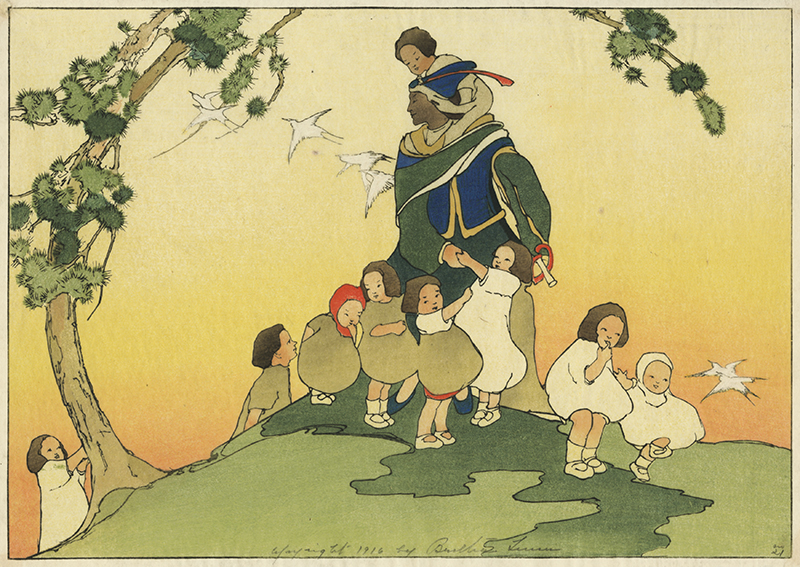The Piper a.k.a. Pied Piper is a color woodcut; created in 1916 by the American born artist, Bertha Lum. The paper is pencil inscribed along the lower image: copyright 1916 by Bertha Lum. The reference for this color woodcut is Gravalos & Pulin 43 and the image measures 9-1/2 x 13-5/8 inches. It is printed on fine laid Japanese paper.
According to the website dedicated to her work, Bertha Lum used between three to thirty blocks to achieve the glowing tonality she was known for. The Piper required twelve blocks to complete. The imagery captures a moment in the famous medieval legend when the Piper, having been left unpaid for his rat-removal services by the greedy townspeople, begins to lure their children away with his pan-pipe tune. Lum gives the scene a bucolic feel, backing the Piper and the joyous children with a glowing, sun-warmed sky.
Bertha Lum (1869-1954), née Bertha Boynton Bull, printmaker and illustrator, was born in Tipton, Iowa and spent her youth in Iowa and Duluth, Minnesota. In 1895, Lum attended the Art Institute of Chicago for one year, focusing on design. A few years later studied stained glass with Anne Weston and illustration at the School of Illustration with Frank Holme. In the fall of 1901 to March 1902, Lum studied figured drawing at the Art Institute of Chicago. In 1903, Bertha married Burt F. Lum, a corporate lawyer, and their honeymoon voyage to Japan in 1903 was the precursor to Bertha’s exploration of and fascination with the Orient. Returning to Japan in 1907 for fourteen weeks, she gained an introduction to Bonkotsu Igami, a master block cutter in Tokyo, who disclosed to her the techniques of carving and arranged for her education in block printing.
Though married, Lum was fiercely independent and traveled for extended periods of time. Accompanied by her two young children, her 1911 sojourn in Japan lasted six months. By this time she had a thorough understanding of color woodcut and opted for the traditional division of labor. Lum moved easily within Japanese society and hers were the only foreign woodcuts in the Tenth Annual Art Exhibition in Tokyo in 1912. She was awarded the silver medal at the 1915 Panama-Pacific International Exposition and and her work was included in the 1919 Exhibition of Etchings and Block Prints at the Art Institute of Chicago. In 1921, Lum’s Summer was included in American Wood-Block Prints of Today at the New York Public Library and, in 1926, an exhibition of her work was mounted in the fall at the United States National Museum, Division of Graphic Arts. She was a member of the Asiatic Society of Japan, the California Society of Etchers, and the Print Makers Society of California. Lum authored and illustrated Gods, Goblins and Ghosts in 1922 and Gangplanks to the East in 1936.
Lum was in California at the end of 1916 and moved to San Francisco in the fall of 1917, but the following years were interrupted with travel. Her most extensive stay in California was between 1924 and 1927. The 1923 earthquake in Tokyo destroyed most of her blocks and many woodcuts. Lum spent the late 1920s and the 1930s living in Peking, returning to California in 1939. She spent a great deal of time in China between the years 1948 and 1953. Bertha Lum left China to be with her daughter Catherine who lived in Genoa, Italy and she died at the age of eighty-four years old in February 1954.
Bertha Boynton Lum is represented in the collections of the Brooklyn Museum, New York; the Art Institute of Chicago and the Terra Foundation for American Art, Chicago; the Jordon Schnitzer Museum of Art, University of Oregon, Eugene; the Amon Carter Museum of American Art, Fort Worth, Texas; the British Museum, London; the Los Angeles County Museum of Art, California; the Zimmerli Art Museum, Rutgers, New Brunswick, New Jersey; the Metropolitan Museum of Art, New York; the Portland Art Museum, Oregon; the Fine Arts Museums of San Francisco, California; the Library of Congress and the National Museum of Women in the Arts, Washington, D.C.; and the Delaware Art Museum, Wilmington.



